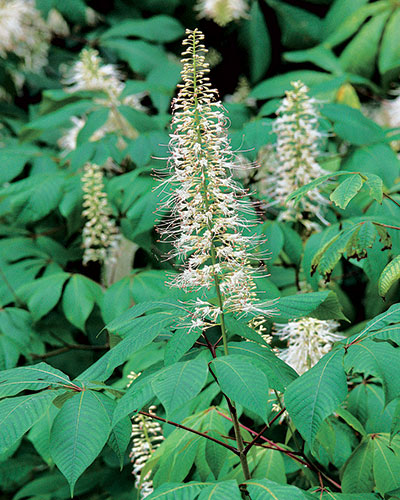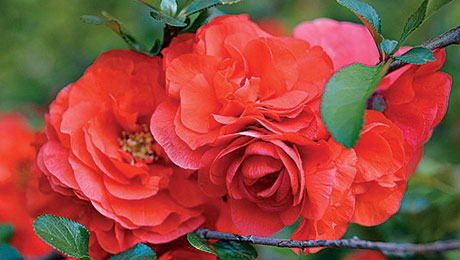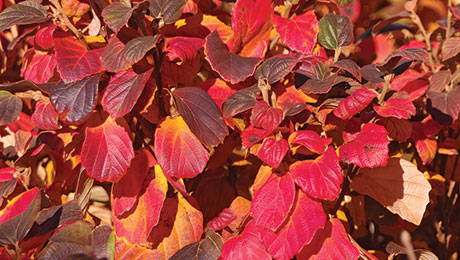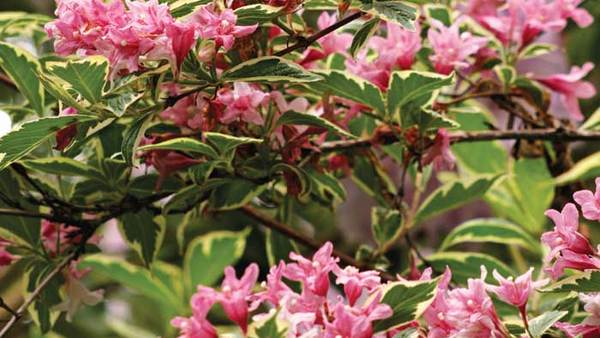
See regional picks for showy shrubs, and read the article by Paul Cappiello for even more ideas.
“Show-stopping shrubs—you know the kind. You’re leading a group of friends around the garden, and they’re politely following you with gin and tonic in hand, oooing and aaahing in slightly hushed tones. And then it happens. They spot something in the distance that throws the whole shebang into chaos. The formerly demure and proper garden folk are throwing sharp elbows as they vie for the best path to whatever it is that caught their collective eye. After all, they’ve got to be the first to Instagram the heck out of it.” Read more Show-Stopping Shrubs.
1. Highbush Blueberry

Name: Vaccinium corymbosum and cvs.
Zones: 5–8
Size: 6 to 12 feet tall and 8 to 12 feet wide
Conditions: Full sun to partial shade; moist, acidic soil
Native range: North America
Yes, it has edible fruit, but that’s not the only reason why I love this plant. You can’t beat the colors this native displays throughout the year: bright red twigs in winter, white flowers in spring, rich blue berries in summer, and a spectacular red-orange foliage show in fall. I have not found a spot where highbush blueberry hasn’t survived, except for areas with alkaline or extremely dry soils. It is the perfect replacement for the invasive burning bush (Euonymus alatus, Zones 4–9). Shear these plants into hedges, plant them randomly in a border with perennials, or prune out the smaller stems at the base and turn them into an eye-catching focal point.
2. Seven-Son-Flower

Name: Heptacodium miconioides
Zones: 5–9
Size: 15 to 20 feet tall and 8 to 10 feet wide
Conditions: Full sun to partial shade; well-drained soil
Native range: China
The first time I saw this plant in its full glory was at the Asticou Azalea Gardens in Maine. It was planted in mass and was in full bloom with white flowers that had a sweet fragrance. Later, I saw it in early winter after a light dusting had left snowflakes in the crevices of its exfoliating bark, and I noticed it was still holding its seed and surrounding red calyxes. Now I had to grow this plant. Although I’ve tried to prune seven-sonflower into a single trunked tree, I find that it looks better as a natural, multistem shrub. A little pruning of the lower branches is warranted so you can see the beautiful bark. The fall color is a nice burgundy too.
3. Little Twist® Mt. Fuji Cherry

Name: Prunus incisa ‘CarltonLT’
Zones: 5–8
Size: 6 to 8 feet tall and wide
Conditions: Full sun; moist, well-drained soil
Native range: Asia
This diminutive cherry is usually found in your local garden center in the form of a top-grafted tree, but it’s even lovelier when grown as a shrub. A dwarf type of a Mt. Fuji cherry, Little Twist® does not get many of the diseases other cherries get. Its branches grow in a unique zigzag pattern, making it an ideal candidate for a focal point or as the star of a container. Beautiful, small, white-pink flowers arrive in spring (you can also cut some branches in late winter to force the blooms inside), followed by small fruits that look like miniature cherries. As if these great traits weren’t enough, in fall the foliage turns spectacular shades of burgundy, red, and orange. Little Twist® takes shearing well, so you can even use it as a hedge.
4. Bottlebrush Buckeye

Name: Aesculus parviflora
Zones: 4–8
Size: 8 to 12 feet tall wide
Conditions: Partial to full shade; moist, well-drained soil
Native range: Southeastern United States Why has this plant seemingly fallen out of favor? It can grow just about anywhere—from the edges of swamps to along highways. The clusters of candlelike flowers in late spring attract all sorts of pollinators while brightening up any shaded garden area. Take a close look and you’ll see red antlers coming out of the throats of white flowers, a trait the hummingbirds love. Bottlebrush buckeye grows into a large, multistem, suckering shrub. It gets beautiful yellow fall foliage too. Several interesting cultivars have been introduced recently—some with taller flowers, some more compact in stature, and others with variegated leaves.
Ed Gregan is a Northeast territory sales representative for Bailey Nurseries and lives in Connecticut.

















Comments
Log in or create an account to post a comment.
Sign up Log in